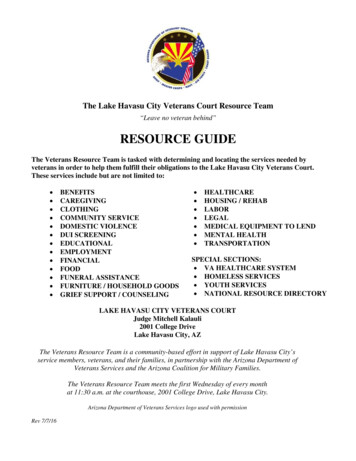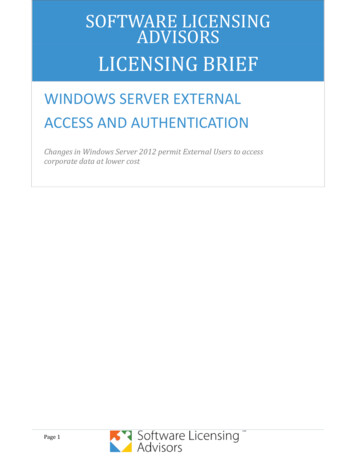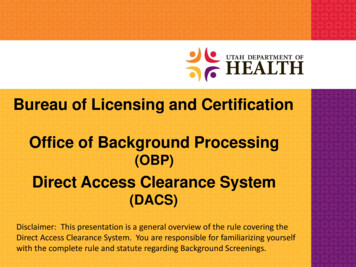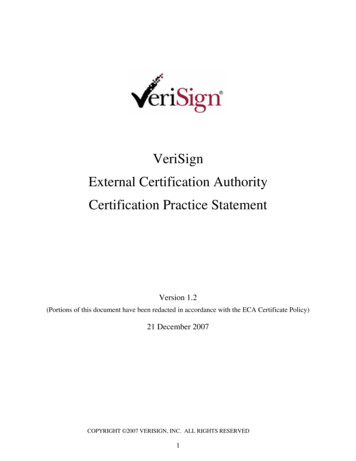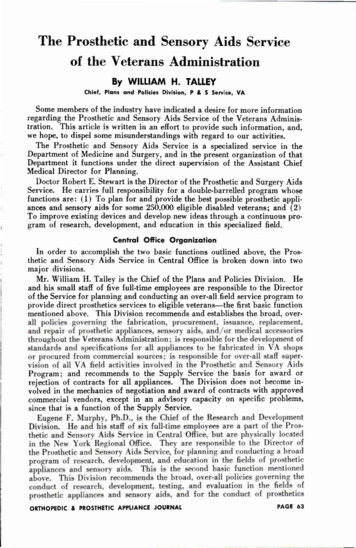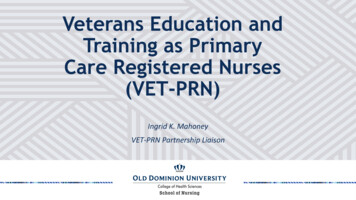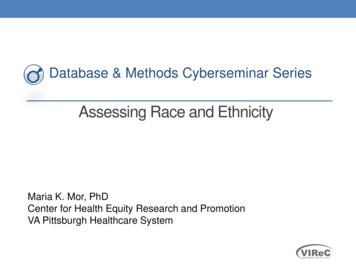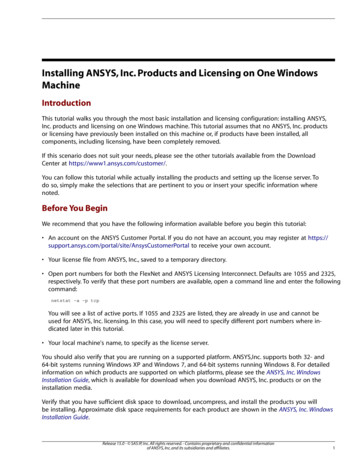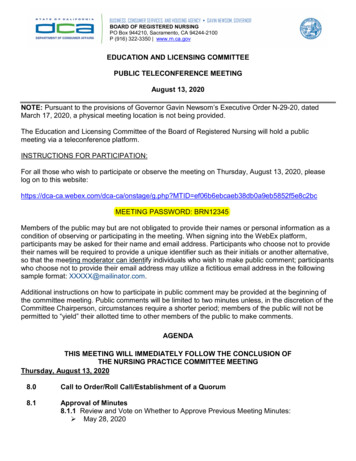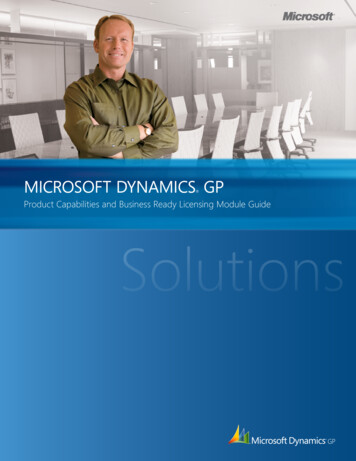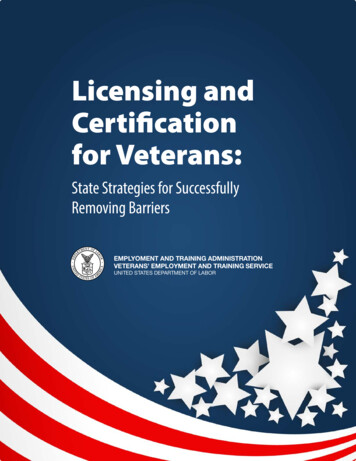
Transcription
Licensing andCertificationfor Veterans:State Strategies for SuccessfullyRemoving BarriersEMPLYOMENT AND TRAINING ADMINISTRATIONVETERANS’ EMPLOYMENT AND TRAINING SERVICEUNITED STATES DEPARTMENT OF LABOR
“Twenty-five millionveterans are livingamong us today. Thesemen and womenselflessly set aside theircivilian lives to puton the uniform andserve us.”–Steve Buyer
LICENSING AND CERTIFICATION FOR VETERANS: STATE STRATEGIES FOR SUCCESSFULLY REMOVING BARRIERSTable of ategies to Address Barriers to Veterans’ Licensing and Certification61. Recognizing Equivalent Military Training and Experience72. Providing Accelerated Training Opportunities83. Streamlining Administrative Processes and RulesThe Blueprint: Successful Implementation of State Strategies in Seven Steps1011Step 1: Assemble a Team12Step 2: Select the Occupations13Step 3: Understand Civilian Employment Requirements and Stakeholders14Step 4: Understand Military Occupational Specialties15Step 5: Produce Gap Analysis to Identify the Appropriate Strategy17Step 6: Market to Veterans19Step 7: Develop an Assessment Plan20Implementation Barriers and Supports21Overcome Implementation Barriers21Implementation Supports22Conclusion24General Resources25Occupation Specific Resources from Demonstration26Bus and Truck Driver26EMT/Paramedic27Law Enforcement28Licensed Practical Nurse/Registered Nurse29Physical Therapy Assistant30UNITED STATES DEPARTMENT OF LABOR1
LICENSING AND CERTIFICATION FOR VETERANS: STATE STRATEGIES FOR SUCCESSFULLY REMOVING BARRIERSAcknowledgementsThe majority of this guide has been taken directly from the September, 2015 Report Veterans’Licensing and Certification Demonstration: A Summary of State Experiences, PreliminaryFindings, and Cost Estimates. As such, the acknowledgments for that Report have beenreproduced in their entirety below:This report was prepared by a team led by Brent Parton with the National Governors AssociationCenter for Best Practices (NGA Center) and Amanda Dunker, formerly with the NGA Center.The report includes significant contributions from a broader project team including MartinSimon and Alisha Powell with the NGA Center, and Elise Shanbacker and Iris Palmer, formerlywith the NGA Center. The report additionally benefitted from the contributions of the team atSolutions for Information Design (SOLID), including Ed Davin, Karen White, Lisa Lutz, and BillBrigman. Valuable peer-review comments were provided by David Moore, Elliot Schwartz, andJennifer Brooks (NGA Center); and by Gloria Salas-Kos and Pamela Frugoli (U.S. Department ofLabor). We also express our gratitude for the substantial support received from the staff of severalother Federal Agencies and national organizations during the planning and implementationphases of the state demonstrations and the NGA Policy Academies. Contributors to the planning,implementation and the NGA Policy Academies include: Marion Cain from the U. S. Departmentof Defense (DoD) (Readiness); Commander Mitchell Seal, Medic Education and Training (Ft.Sam Houston); Doctor Maryann Alexander, National Council of State Boards of Nursing; DiaGainor, National Association of State EMS Officials; Severo Rodriguez and Terry Markwood withthe National Registry of Emergency Medical Technicians; LTC Arturo Calzadillas, Jr. with Soldierfor Life; Selden Fritschner, U. S. Department of Transportation Federal Motor Carrier SafetyAdministration; Dr. Leslie Adrian of the Federation of State Boards of Physical Therapy; JohnAwtrey, Law Enforcement Policy and Support, DoD; Steve Gonzales, American Legion VeteransEmployment and Training Division; Rodrigo Garcia, Student Veterans of America; and BobSimoneau of the National Association of State Workforce Agencies.UNITED STATES DEPARTMENT OF LABOR2
LICENSING AND CERTIFICATION FOR VETERANS: STATE STRATEGIES FOR SUCCESSFULLY REMOVING BARRIERSIntroductionMilitary servicemembers on active duty are the beneficiaries of extensive training that preparesthem to perform in a wide range of occupational specialties. Many of those occupationalspecialties have direct or proximate equivalents in the civilian workforce, but transitioningservicemembers might lack the relevant civilian occupational credentials required under federalor state law or by an employer to secure employment. Despite their relevant skills and experience,veterans can encounter lengthy processes and requirements to obtain the credentials neededto enter civilian employment. These barriers can impose additional time and financial costs onveterans and taxpayers, who pay both for the initial military training and for re-training outsideof the military, primarily through veterans’ federal education benefits.In response, the federal government has undertaken several initiatives to streamline andaccelerate civilian licensing and certification for current service members and veterans. Theinitiatives undertaken resulted from new intergovernmental efforts across Federal agencies,including the military, to identify equivalencies between military and civilian occupations andprovide civilian credentials.The ultimate authority for regulating entry intomost professions lies with state governments.Although Federal agencies and nationalprofessional associations can propose standardsand guidelines, state licensing boards make finaldecisions about whether alternative pathways areadequate to uphold public safety standards basedon professional requirements, occupational skillcompetencies, and state laws and regulations. Thenation’s governors recognize that authority andhave made the transition for veterans from militaryservice to civilian life and employment a priorityin the states. Thirty-nine states issued executiveorders or passed legislation to assist veteranswith recognizing and transferring skills gained inmilitary service to civilian employment between2013 and 2015. In addition, for CommercialDriver’s Licenses (CDLs), all 50 states haveimplemented the Military Skills Test Waiver accordingto the specific administrative procedures applicablewithin each state.“In November 2015, I startedthinking about my career outsideof the military and the directionI wanted to go. I immediatelygravitated toward the truckingindustry because I was a truckdriver in the Marine Corps. WhileI was back in Florida for a noncommissioned officer course,I took the time to get my classA CDL through the MilitarySkills Waiver Test so I would beprepared when the time came totransition out of the military.”UNITED STATES DEPARTMENT OF LABORSgt. Richard StewartUnited States Marine Corps3
LICENSING AND CERTIFICATION FOR VETERANS: STATE STRATEGIES FOR SUCCESSFULLY REMOVING BARRIERSAlthough critical for elevating the importance of accelerating employment pathways forveterans, legislation and executive orders can only go so far to help veterans transition to civilianemployment. States encounter a range of challenges implementing the related policies andsubsequent requirements amid the complexity of state licensure and third-party certificationsystems. This guide is intended to help states move beyond the legislative and policy intent ofmaking veterans a priority to the design and implementation of accelerated pathways to licensureand certification for veterans.Section 237 of the Veterans’ Opportunity to Work to Hire Heroes Act of 2011 (VOW Act)authorized the Department of Labor Veterans’ Employment and Training Service (DOL-VETS)to carry out a demonstration project for the purpose of facilitating the transition of members ofthe Armed Forces from service on active duty to civilian employment. DOL-VETS, in partnershipwith the Department of Labor Employment and Training Administration (DOL-ETA), partneredwith the National Governors Association Center for Best Practices (NGA Center) to implementthe demonstration project. Six states participated in the 18-month demonstration: Illinois,Iowa, Minnesota, Nevada, Virginia, and Wisconsin. Each demonstration state selected up tothree high-demand occupations, for a total of seven occupations across all six states, to focustheir licensing and credentialing strategies that corresponded with one of the three pre-selectedmilitary occupational specialties: Medic (Army 68W, Navy Hospital Corpsman, Air Force4N0X1), Police (Army 31B, Navy Master-At-Arms, Air Force 3P0X1, Marine Corps 5811), andTruck Driver (Army 88M, Marine Corps 3531). The resulting Report serves as the primary sourceof the guidelines and strategies found in this guide. While this guide does not recreate the Reportin its entirety, it draws upon the Report to identify common barriers, describe strategies forovercoming them, and present a blueprint that can inform State-led efforts to accelerate veterans’licensing and certification. States are encouraged to utilize the entire Report and appendices whendeveloping their own strategic plans to address veterans’ licensing and certification.UNITED STATES DEPARTMENT OF LABOR4
LICENSING AND CERTIFICATION FOR VETERANS: STATE STRATEGIES FOR SUCCESSFULLY REMOVING BARRIERSBarriersA number of factors can affect the ability of servicemembers and veterans to acquire civiliancredentials in related occupations on a timely basis. The demonstration states identified threetypes of barriers commonly encountered:1. Veterans who havemilitary trainingand experience inoccupations relatedto those of licensedcivilians oftenfind that relevantauthorities, such aslicensing boards, orhigher educationinstitutions maynot to recognizethe militarydocumentation oftheir training andexperience.2. Veterans whoexperience gaps,between theirmilitary occupationtraining andexperience andcivilian occupationrequirements,are more likelyto participatein duplicativetraining to acquirerelevant licensure orcertification.UNITED STATES DEPARTMENT OF LABOR3. State administrativerules and processeswithin civilianlicensing andcredentialingsystems can createhurdles for veteranswho want toobtain licensure orcertification; andthese hurdles areoften unrelatedto their abilityto competentlyprovide professionalservices to thepublic.5
LICENSING AND CERTIFICATION FOR VETERANS: STATE STRATEGIES FOR SUCCESSFULLY REMOVING BARRIERSStrategies to Address Barriers to Veterans’ Licensingand CertificationThis section describes the strategies states can use to accelerate licensing and certification forveterans, provides a step-by-step blueprint states can use to identify, design and implementthose strategies, and offers lessons learned from the implementation of those strategies bydemonstration states. Additional state-specific strategies are available for review in Appendix III(pg. 62) of the final Report, where they are organized by occupation.While a number of factors can affect the ability of servicemembers and veterans to attain civiliancredentials on a timely basis, the demonstration States successfully employed three types ofstrategies to support veterans’ transition to the civilian workforce by:123 Recognizing equivalent militarytraining and experience Providing accelerated trainingopportunities to fill gaps in militarytraining and experience, and Streamlining administrativerequirements and processes.UNITED STATES DEPARTMENT OF LABOR6
LICENSING AND CERTIFICATION FOR VETERANS: STATE STRATEGIES FOR SUCCESSFULLY REMOVING BARRIERS1. Recognizing Equivalent Military Training and ExperienceCivilian credentialing agencies have different eligibility requirements for attaining occupationallicenses or other credentials. Eligibility requirements might typically include a combinationof education and training, work experience, or prerequisite certifications. Each eligibilityrequirement presents different challenges in terms of the ability of servicemembers and veteransto use their military training and experience to meet civilian credentialing requirements.There were two common approaches implemented by the demonstration states to address thischallenge: Licensure by endorsement to advance or increase reciprocity among states, and Licensure by exam to minimize duplication in coursework.Licensure by Endorsement: If state licensing boards determine that there is full equivalencybetween military preparation and civilian preparation, veterans can be licensed by endorsementwithout additional training or exams. States commonly use endorsement when an individualholds a license in another state, and it is most appropriate for occupations for which there arerecognized national certification exams.– In Iowa, the state Emergency Medical Services (EMS) Office reviewed the trainingprovided to medics and corpsmen and designated it an approved training program,allowing veterans with an active national Emergency Medical Technician (EMT)certification to apply for an Iowa EMT license without additional training or testing.– In Illinois, former medics with an active national EMT certification can apply for anIllinois EMT license.– In Virginia, former medics with an active EMT certification also can apply for a state EMTlicense.Licensure by Exam. If it is not appropriate for a state to award a license by endorsement, a statemay be able to waive the requirement for veterans to complete an approved civilian trainingprogram as a condition to sit for a state licensure exam and may be able to grant permission to sitfor the exam based on military training and experience alone. In that case, states can use the examto demonstrate that the candidate has sufficient knowledge to practice competently.– In Minnesota, former military police that meet experience requirements (four years ortwo years with a postsecondary degree) can apply to sit for a military reciprocity exam.– Wisconsin’s Law Enforcement Accelerated Development Program allows veterans who haveseparated within the past three years and who have at least one year of experience as amilitary police officer to take a reciprocity exam and become certified with no additionaltraining.UNITED STATES DEPARTMENT OF LABOR7
LICENSING AND CERTIFICATION FOR VETERANS: STATE STRATEGIES FOR SUCCESSFULLY REMOVING BARRIERS2. Providing Accelerated Training OpportunitiesWhen there is partial overlap between the skillset used in a military occupation and that isneeded for a similar civilian occupation, states can provide shortened training opportunitiesfor veterans that focus on filling specific gaps. Such strategies for states include working witheducation providers to: Establish bridge programs designed specifically around veterans’ training needs, and Help veterans waive required courses by awarding credit for military training or advancedstanding within an existing training program.Bridge Programs: Bridge programs were the most prevalent strategy demonstration statespursued. In some cases they developed new programs and in others they identified existingaccelerated programs and made them more accessible to veterans.Illinois developed a new veteran bridge program curriculum for Licensed Practical Nurses (LPNs)and through the demonstration, implemented the program at two community colleges, each ofwhich will reduce the training time for medics by half.Minnesota and Wisconsin identified and adapted existing civilian bridge programs for veterans.In Minnesota, separating and veteran military medics now can take advantage of an existingprogram that accelerates training for civilian EMTs interested in moving up to paramedics. InWisconsin, the Vet2RN program adapted an existing LPN to RN pathway for medics who have theopportunity to accelerate progress towards an LPN license and continue to the RN level.Course Credit and Advanced Standing. Another strategy to accelerate training periods isto provide academic credit for military training and work experience. In some cases, awardedcredits become part of a post-military veterans’ academic transcript. In other cases, waived courserequirements can provide advanced standing in a training or degree program. Both processescan decrease the time veterans spend in existing training programs to meet civilian licensurerequirements.To provide credit for training and experience the military provides various forms of officialdocumentation that are similar in nature to the official academic transcripts that a civilianwould submit from a civilian educational institution. For example, the Air Force operates theregionally accredited Community College of the Air Force (CCAF). As a result, for Air Forceveterans, military training is documented on a standard academic transcript issued by CCAF. Inaddition to awarding academic credit for training, CCAF also assesses certain aspects of militaryoccupational experience for the award of academic credit. The other three Services (Army,Navy and Marine Corps), however, rely on the American Council on Education (ACE) to reviewtheir military training and experience to recommend appropriate amounts of academic credit.Based on the ACE credit recommendations for those three Services, the Joint Services Transcript(JST) documents the military training and the military occupational experience that have beenreviewed by ACE and makes academic credit recommendations.UNITED STATES DEPARTMENT OF LABOR8
LICENSING AND CERTIFICATION FOR VETERANS: STATE STRATEGIES FOR SUCCESSFULLY REMOVING BARRIERSIn most cases postsecondary education institutions develop their own policies for assessing priorlearning and granting advanced standing in education programs. States are encouraged to workclosely with postsecondary education institutions to award credit and advanced standing toveterans with relevant military training and experience.In Minnesota Lake Superior College awards course credit for 27 required Physical Therapy Assistant(PTA) courses to former military PTAs, reducing the credits needed for the degree to 20.In January 2017, Lake Superior College will be the first college to offer a Minnesota Departmentof Veterans Affairs-approved practical nursing program for vets with medic field experience.Wisconsin’s Herzing University now offers advanced standing for former medics entering theAssociate Degree in Nursing program. The medics join the program as second semester students andcan take the National Licensure Council Examination for Licensed Practical Nurses (NCLEX-PN) exam afterone semester or continue on to receive an associate’sdegree in two semesters.Illinois, Iowa, Minnesota, and Wisconsin now participatein the Multi-State Collaborative on Military Credit led by theMidwestern Higher Education Compact. The threeyear, grant- funded initiative began in November 2014and brings together 13 states to “advance best practicesdesigned to ease the transition of veterans and theirfamilies from military life to college campuses. It makesspecial reference to translating competencies acquiredthrough military training and experiences into milestonestoward completing a college degree or earning acertificate or license.”UNITED STATES DEPARTMENT OF LABOR“I’m a medic with the477th Med Company inDuluth, Minnesota. LSC’sMilitary Bridge Medic toLPN program will giveme a huge boost towardsmy goal of becoming aregistered nurse.”Sgt. Darold “Bud” LindmanUS Army 477th Medical Company9
LICENSING AND CERTIFICATION FOR VETERANS: STATE STRATEGIES FOR SUCCESSFULLY REMOVING BARRIERS3. Streamlining Administrative Processes and RulesSome requirements for civilian licensure are unrelated to an individual’s skills or knowledge,such as application fees and conditional offers of employment for public safety personnel. Statesshould identify opportunities to address administrative processes and regulations in ways thatdo not affect their substance, but reduce barriers for veterans looking to apply their militarytraining experience within the civilian workforce. Examples of such strategies include waivingadministrative fees, ensuring quick turnaround of applications, making information about thelicensing process more accessible, and aligning rules such as experience requirements with typ
military occupational specialties: Medic (Army 68W, Navy Hospital Corpsman, Air Force 4N0X1), Police (Army 31B, Navy Master-At-Arms, Air Force 3P0X1, Marine Corps 5811), and Truck Driver (Army 88M, Marine Corps 3531). The resulting . Report. serves as the primary sou
